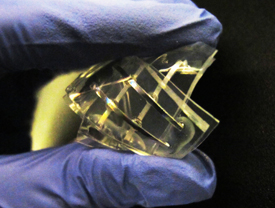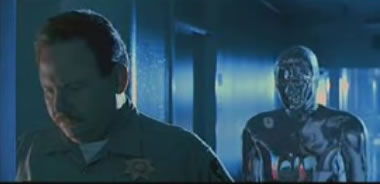Science Fiction
Dictionary
A B C D E F G H I J K L M N O P Q R S T U V W X Y Z
Soft Biocompatible Memory Device

Biocompatible electronic devices created by North Carolina State researchers are soft and function well in wet environments. “We’ve created a memory device with the physical properties of Jell-O,” says Dr. Michael Dickey, an assistant professor of chemical and biomolecular engineering at NC State.

(Biocompatible electronic devices)
Conventional electronics are typically made of rigid, brittle materials and don’t function well in a wet environment. “Our memory device is soft and pliable, and functions extremely well in wet environments – similar to the human brain,” Dickey says.Prototypes of the device have not yet been optimized to hold significant amounts of memory, but work well in environments that would be hostile to traditional electronics. The devices are made using a liquid alloy of gallium and indium metals set into water-based gels, similar to gels used in biological research.
The device’s ability to function in wet environments, and the biocompatibility of the gels, mean that this technology holds promise for interfacing electronics with biological systems – such as cells, enzymes or tissue. “These properties may be used for biological sensors or for medical monitoring,” Dickey says.
The device functions much like so-called “memristors,” which are vaunted as a possible next-generation memory technology. The individual components of the “mushy” memory device have two states: one that conducts electricity and one that does not. These two states can be used to represent the 1s and 0s used in binary language. Most conventional electronics use electrons to create these 1s and 0s in computer chips. The mushy memory device uses charged molecules called ions to do the same thing.
In each of the memory device’s circuits, the metal alloy is the circuit’s electrode and sits on either side of a conductive piece of gel. When the alloy electrode is exposed to a positive charge it creates an oxidized skin that makes it resistive to electricity. We’ll call that the 0. When the electrode is exposed to a negative charge, the oxidized skin disappears, and it becomes conducive to electricity. We’ll call that the 1.
Normally, whenever a negative charge is applied to one side of the electrode, the positive charge would move to the other side and create another oxidized skin – meaning the electrode would always be resistive. To solve that problem, the researchers “doped” one side of the gel slab with a polymer that prevents the formation of a stable oxidized skin. That way one electrode is always conducive – giving the device the 1s and 0s it needs for electronic memory.
(Liquid metal forms basis of soft biocompatible memory)
I was also fascinated by the idea that an electronic memory device could have liquid metal components, as it makes me think of one of my favorite movie villains.

(Terminator 2 liquid metal robot)
From Towards All-Soft Matter Circuits: Prototypes of Quasi-Liquid Devices with Memristor Characteristics via MedGadget.
Scroll down for more stories in the same category. (Story submitted 7/22/2011)
Follow this kind of news @Technovelgy.| Email | RSS | Blog It | Stumble | del.icio.us | Digg | Reddit |
Would
you like to contribute a story tip?
It's easy:
Get the URL of the story, and the related sf author, and add
it here.
Comment/Join discussion ( 0 )
Related News Stories - (" Robotics ")
Golf Ball Test Robot Wears Them Out
"The robot solemnly hit a ball against the wall, picked it up and teed it, hit it again, over and again...' - Frederik Poh, 1954.
PaXini Supersensitive Robot Fingers
'My fingers are not that sensitive...' - Ray Cummings, 1931.
Artificial Skin For Robots Is Coming Right Along
'... an elastic, tinted material that had all the feel and appearance of human flesh and epidermis.' - Harl Vincent (1934)
Robot Guard Dog On Duty
I might also be thinking of K-9 from Doctor Who.
Technovelgy (that's tech-novel-gee!) is devoted to the creative science inventions and ideas of sf authors. Look for the Invention Category that interests you, the Glossary, the Invention Timeline, or see what's New.
Science Fiction
Timeline
1600-1899
1900-1939
1940's 1950's
1960's 1970's
1980's 1990's
2000's 2010's
Current News
Golf Ball Test Robot Wears Them Out
"The robot solemnly hit a ball against the wall, picked it up and teed it, hit it again, over and again...'
Boring Company Vegas Loop Like Asimov Said
'There was a wall ahead... It was riddled with holes that were the mouths of tunnels.'
Rigid Metallic Clothing From Science Fiction To You
'...support the interior human structure against Jupiter’s pull.'
Is The Seattle Ultrasonics C-200 A Heinlein Vibroblade?
'It ain't a vibroblade. It's steel. Messy.'
Roborock Saros Z70 Is A Robot Vacuum With An Arm
'Anything larger than a BB shot it picked up and placed in a tray...'
A Beautiful Visualization Of Compact Food
'The German chemists have discovered how to supply the needed elements in compact, undiluted form...'
Bone-Building Drug Evenity Approved
'Compounds devised by the biochemists for the rapid building of bone...'
Secret Kill Switch Found In Yutong Buses
'The car faltered as the external command came to brake...'
Inmotion Electric Unicycle In Combat
'It is about the size and shape of a kitchen stool, gyro-stabilized...'
Grok Scores Best In Psychological Tests
'Try to find out how he ticks...'
PaXini Supersensitive Robot Fingers
'My fingers are not that sensitive...'
Congress Considers Automatic Emergency Braking, One Hundred Years Too Late
'The greatest problem of all was the elimination of the human element of braking together with its inevitable time lag.'
The Desert Ship Sailed In Imagination
'Across the ancient sea floor a dozen tall, blue-sailed Martian sand ships floated, like blue smoke.'
The Zapata Air Scooter Would Be Great In A Science Fiction Story
'Betty's slapdash style.'
Thermostabilized Wet Meat Product (NASA Prototype)
There are no orbiting Michelin stars. Yet.
Could Crystal Batteries Generate Power For Centuries?
'Power could be compressed thus into an inch-square cube of what looked like blue-white ice'
